Article
Dr. Mütter's Marvels: A Book for a Winter's Night
Author(s):
Cristin O'Keefe Aptowicz's Dr. Mütter's Marvels tells an engaging tale of a medical pioneer.
I didn’t know the details of the life of Thomas Dent Mütter, MD, (1811-1859) until I absorbed Cristin O’Keefe Aptowicz’s meticulously sourced Dr. Mütter’s Marvels, published in September 2014.
I had an elderly patient in the late 1960s when I worked in New Hampshire in the trenches of family practice. She would sometimes charm me (I’d come into the examining room and she’d start, “Well, Eric, what mischief have you been up to today?”) and sometimes she’d frustrate me with her observations—criticisms actually—of my therapeutic skills. She’d say, “My aunt says you’ve made the wrong diagnosis and your treatment is all wrong!”
I’d shrug this off sometimes but it must have been threatened my hubris one day because I haughtily said to this little old lady, “And where did your aunt with all this knowledge go to medical school?”
My patient cackled and said, “Women’s Medical College of Pennsylvania, Class of 1899.”
That made me more tolerant of what Auntie said. But I’ve always had pronounced respect for the medical schools of Pennsylvania. After all, 5 graduates of my medical school in Edinburgh, Scotland created America’s first med school, (the Medical School of the College of Pennsylvania) from its founder John Morgan, MD to 4 other members of its first faculty including Benjamin Rush, MD, a signatory of the Declaration of Independence.
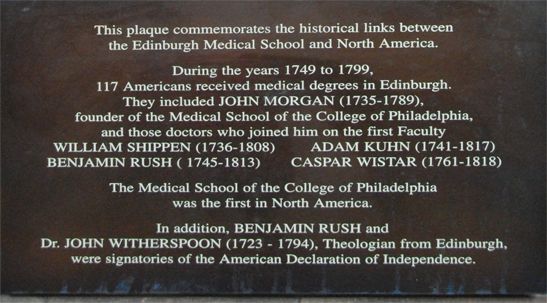
I would see a plaque to that effect on the Edinburgh University New Quad wall. I’d walk past it every day in my preclinical years.
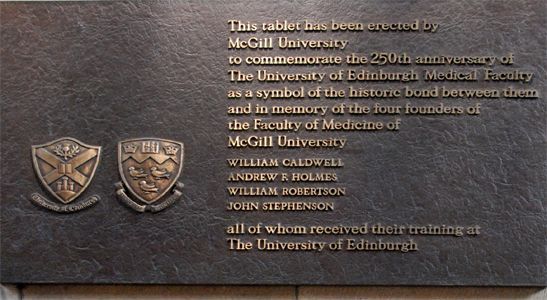
But while I’m name dropping and bragging about my medical school as some graduates tediously do, I should mention our graduates also started Montreal’s celebrated McGill University and with James Lind educated a ship’s doctor who finally found the cause of scurvy.
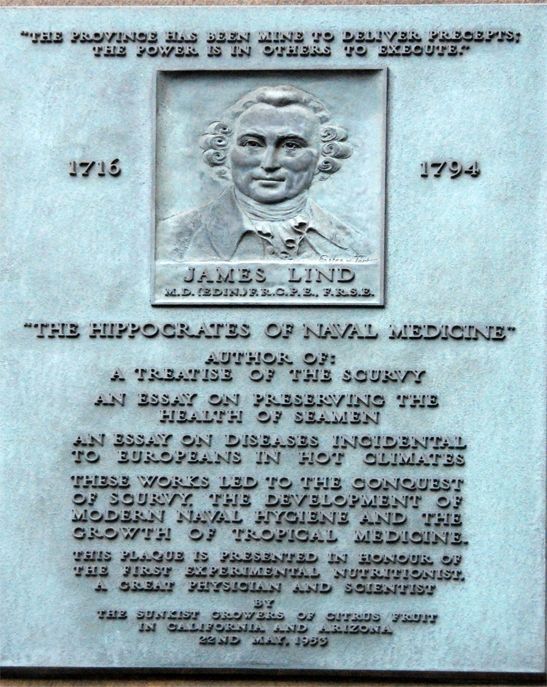
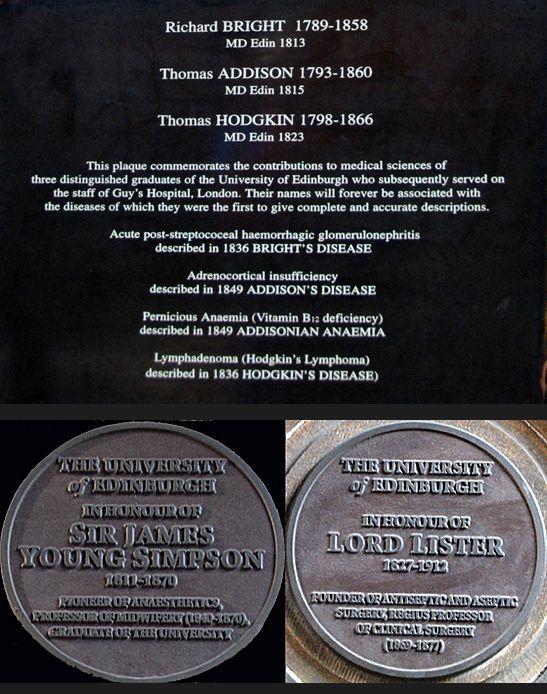
And in Bright, Addison, and Hodgkin Edinburgh graduated 3 in the early 19th century who would impact renal disease, adrenocortical insufficiency, pernicious anemia, and lymphoma. As students we walked the same halls as, earlier, Simpson had done when not considering the medical use of chloroform and Lister the benefit of carbolic spray. The same halls Bennett had paced to understand leukemia.

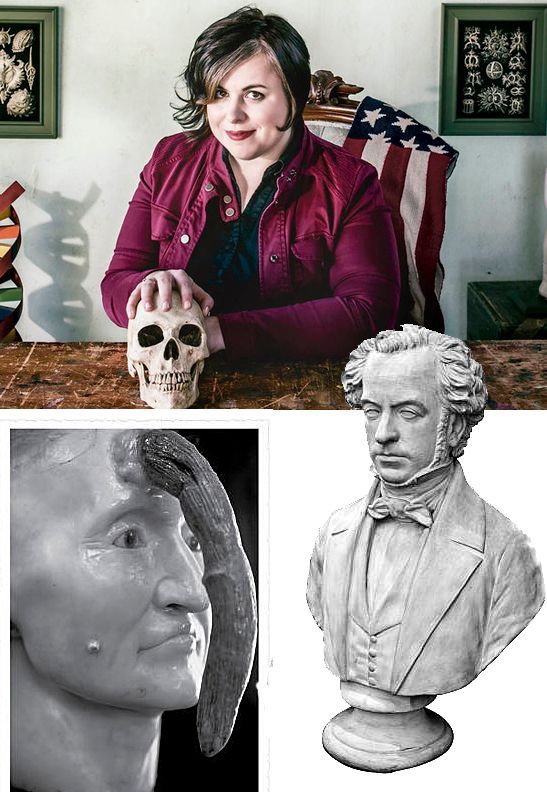
Cristin O’Keefe Aptowicz. Wax replica of woman with cutaneous horn that Mütter brought back from Paris. Bust of Thomas Dent Mütter (he added the umlaut in Paris.)
But all this historic musing comes from reading about Mütter’s Marvels although there is nothing in Aptowicz’s rather breathless book to tell us that the museum expanded after his death so it acquired such gripping items as Benjamin Rush’s medical chest, the tumor removed from Grover Cleveland’s jaw, Marie Currie’s electrometer, and even slices of Einstein’s brain.
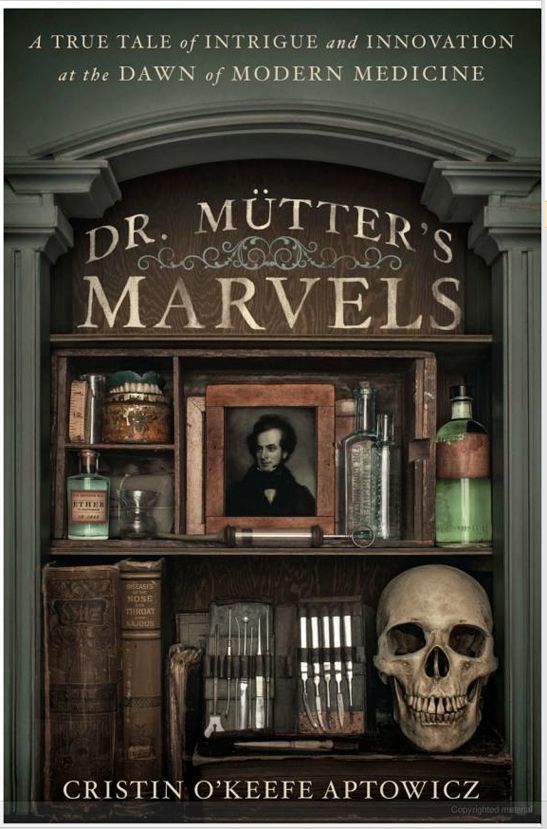
Jacket and design by Dan Winters and Stephen Brayda.
I had thought the book would discuss the many oddities in Philadelphia’s Mütter Museum—which would have been interesting enough—but this 370-page volume does not deal much with the museum but rather with the fascinating 19th Century development of American medical school education and Jefferson Medical College’s famous Faculty of 1841 which Mütter was invited to join.
Volumes 25-26 of the Boston Medical Surgical journal pay tribute to this 1841 faculty of which Mütter was thrilled to be a member so early in a life that lasted only 47 years. He was born in 1811 and died in 1859.
Mütter graduated from the University of Philadelphia Medical College at the age of 20. An orphan with a small trust that barely met his expenses, he couldn’t afford passage to study further in Paris as many Americans did then. Somehow he managed to sail to France as a surgeon’s mate on a ship built in the Philadelphia shipyard for the Imperial Russian Navy. In Paris he studied under the famous surgeon Guillaume Dupuytren (of the eponymous palmar tendinitis contracture) and Jacques Lisfranc (who similarly gave his name to the midfoot fracture, a high energy injury still often seen in sports). The 2 French surgeons were former friends who became spiteful rivals, something Mütter would discover later in Philadelphia.
Mütter was awe-inspired to discover there was a new specialty being developed by French surgeons les opérations plastiques. Not all operations were successful, says Aptowicz. “But other times—and these were the times the audience waited for, the ones that made Mütter’s hair stand on end—the end result was nothing short of miraculous.”
Aptowicz has written an absorbing, extensively researched and documented biography. If at times the style seems Old World, even flattering, we have to remember Aptowicz is really a poet whose 6 previous books were all poetry; and her previous nonfiction book had been on 20 years of poetry slams in New York City—and Mütter was a most engaging person. He led a flamboyant life that gathered devoted students, was in the vanguard of this new exciting field of plastic surgery, and was described as the [P.T.] “Barnum of the surgery room.”
Aptowicz‘s research does not clarify (nor do online search engines) why Mütter was a sickly child and had recurrent bouts of coughing with blood-stained sputum. It was the era of tuberculosis but that is not mentioned. He did have gout. Did he perhaps have bronchiectasis or some vascular abnormality in his lungs? Who knows?

But what you will know when, reluctantly, you finish this book is what medical school education was like in the first part of the 19th Century and, perhaps, what a privilege it still is to graduate with today’s medical education and confront what to many doctors remains a calling: being a physician.
Photography by Anderson published here courtesy of Gotham and Penguin Books, Dan Winters. Stephen Brayda, book author Cristin O’Keefe Aptowicz, Jefferson Medical College and the Mütter Museum.
The Andersons, who live in San Diego, are the resident travel & cruise columnists for Physician's Money Digest. They have written about Amsterdam’s Vrolik medical museum and many others in Europe, and have given book reviews for what they believed would be interesting reads for doctors. Nancy is a former nursing educator, Eric a retired MD. The one-time president of the NH Academy of Family Physicians, Eric is the only physician in the Society of American Travel Writers. He has also written 5 books, the last called The Man Who Cried Orange: Stories from a Doctor's Life.




